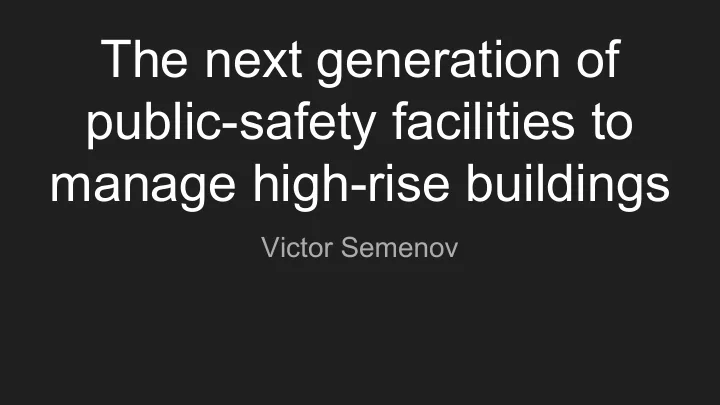

The next generation of public-safety facilities to manage high-rise buildings Victor Semenov
WHO AM I? ● Chief Technology Officer at TowerIQ. ● I’ve been developing public-safety solutions for the last 3 years, primarily for the US market. I spent 2 years as a technical lead and last year as a CTO. ● I started my career as an embedded engineer from the lowest level of programming.
Modern urban trends ● Global skyscraper construction is up 802% since 2000.
Modern urban trends ● A skyscraper is a building taller than 150m or approximately over 40 floors. ● A high-rise building is construction that is taller than 35 meters or approximately 12 floors. ● The number of high-rise buildings is growing around the world, and drastically. Some examples are: City\Year 2011 2018 New York 5,924 6,436 Kiev 1,531 2,066 Moscow 3,273 12,346 Shanghai 990 25,000+ (approx.)
What systems are we talking about? ● Two-way radio communication enhancement systems ● Fire alarm ● Mass notification ● Fire suppression ○ Sprinkler system ○ Stairwell pressurisation ● Standpipe ● Automatic transfer switch ● Emergency lighting
Developers’ main concerns ● Do you think the hardest puzzle for engineers is to build higher? ● The main and the hardest barrier in high-rise building construction is safety concerns: infrastructure and facilities. ● The higher a building is: ○ the harder it is to evacuate ○ the harder it is to supply with water for firefighting ○ the harder it is to coordinate first responders communications inside the building
Do we really need this? ● Two-way radio communication enhancement system “ As important as water ” - Michael Yohannan, FDNY Bureau Fire Prevention
Do we really need this? ● Two-way radio communication enhancement system “ As important as water ” - Michael Yohannan, FDNY Bureau Fire Prevention
Do we really need this? ● Fire alarm Most incidents avoided human losses due to successful and timely evacuations, thanks to fire alarms and mass notification systems. “ Under the testing conditions, a 520 Hz square wave sound woke up 92% of hard-of-hearing participants, making it the most effective. ” - NFPA study
Do we really need this? ● Fire suppression - Sprinklers Fact: “ 90% of all fires are controlled with six or fewer heads . A study conducted during 80 years of automatic sprinkler use found that 82% of the fires that have occurred were controlled by two or fewer sprinkler heads. ” - TUFTS University
Do we really need this? ● Fire suppression - Stairwell pressurisation Properly working systems can maintain a smoke-free stairwell (escape route) for at least 2 hours. This allows most tenants to leave the building.
Problems ● Most of the time reliable infrastructure stays unused ● Public-safety facilities are installed at property owners’ expense ● Maintenance is privately funded as well ● Owners choose cheapest possible solutions ● Old technologies are widely used (limited or absent use of wireless technologies and cloud services)
Our focus Infrastructure and Water facilities Air/smoke facilities monitoring
Current solutions - Communication & Monitoring ● Tactical Series ● Communication is extremely important. Currently most of the high-rise buildings in the US are equipped with two-way radio communication systems. ● It provides complete supervision and control over communication system. ● It monitors and analyses thousands of system performance indicators and reports it to the fire command centre.
Coming soon - data conveyance & edge processing ● TowerLinQ ● Current system integrity is poor: usually building’s fire alarms trigger local fire departments and the department follows up. ● TowerIQ makes fire grade infrastructure available for commercial use with TowerlinQ and TIQ.cloud service. ● Similar to how mobile carriers provide coverage for mobile communications, TowerlinQ provides 100% in-building coverage for IoT devices of all kinds: ○ Access control nodes ○ Fan/lighting control ○ Environmental sensors ○ Any third party device
Coming soon - data conveyance & edge processing ● TowerLinQ & CitiLinQ ● The Building Information Server makes each building act as a small data centre. It can process collected data at the facility. ● CitilinQ provides mesh topology communication to other buildings and outdoor terminal devices. ● In case of an incident, all commercial services are sacrificed to give way to first responders’ communications.
The Big Idea - Inter-system integration ● TIQ.cloud ● We dream of safe, connected cities and believe that most of the required facilities will be made better by others. ● We provide API for third parties (government, integrators, hobbyists), so they can deploy any outdoor and indoor system or even a single device. ● We provide robust and reliable infrastructure, with no additional charge for property owners. ● We increase reliability by implementing mesh networking.
Thank you! Questions? vsemenov@toweriqua.com We did that → ● 8 km of cabling ● 250 antennas
Recommend
More recommend